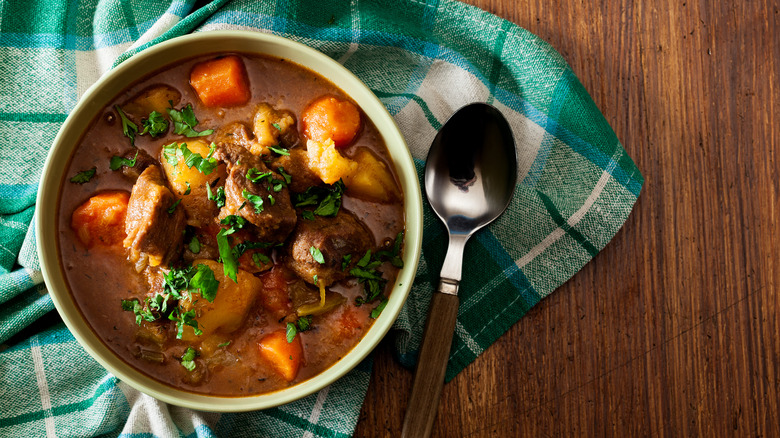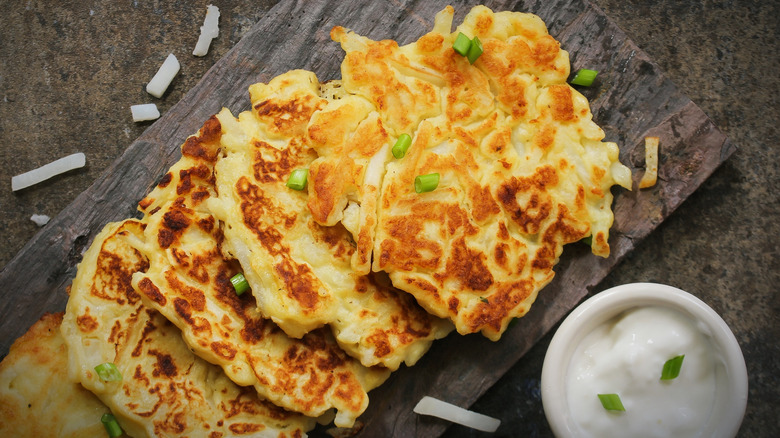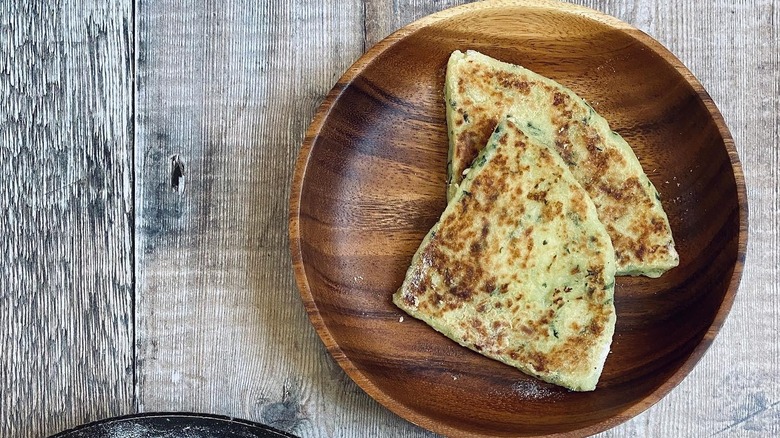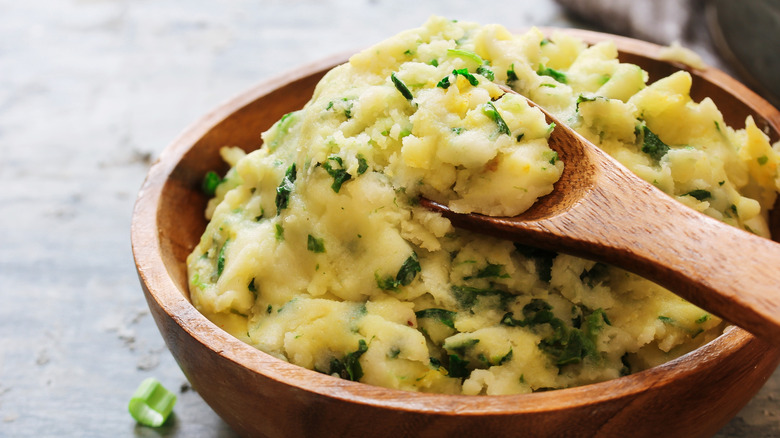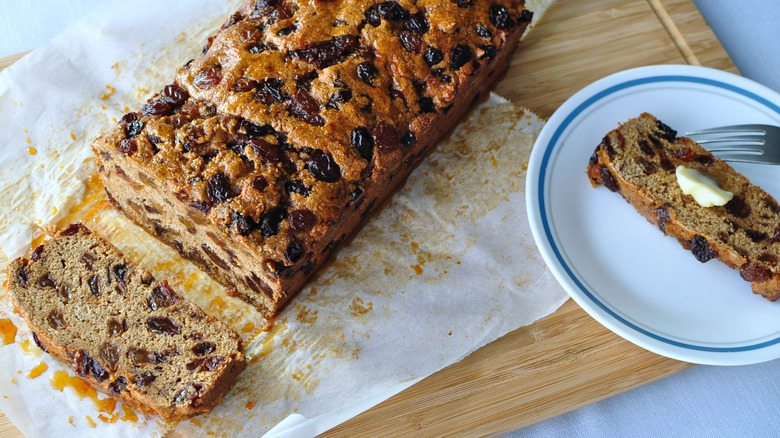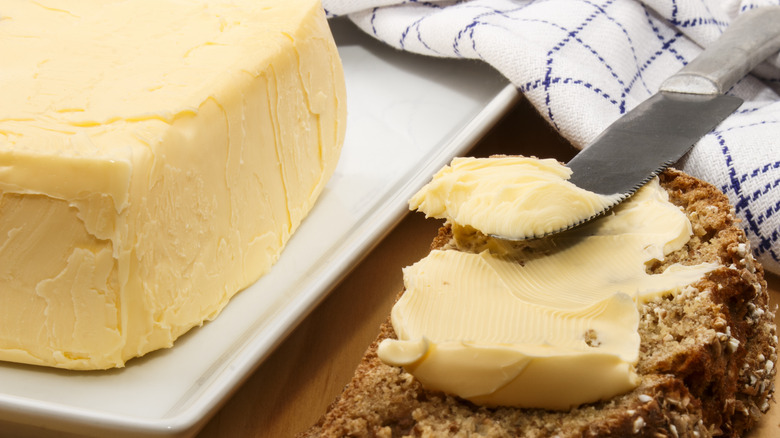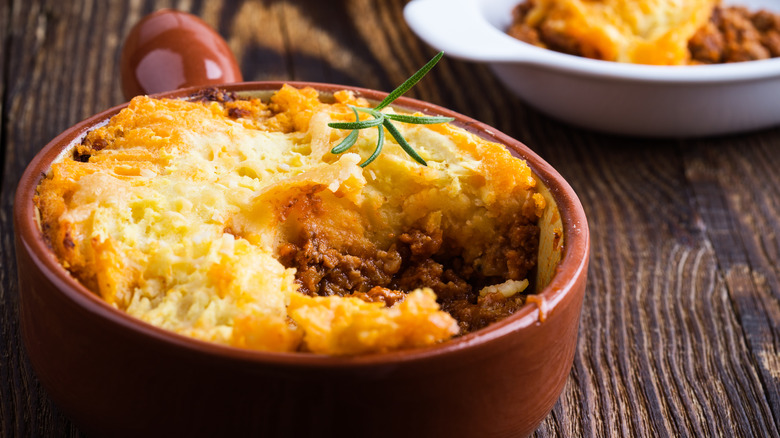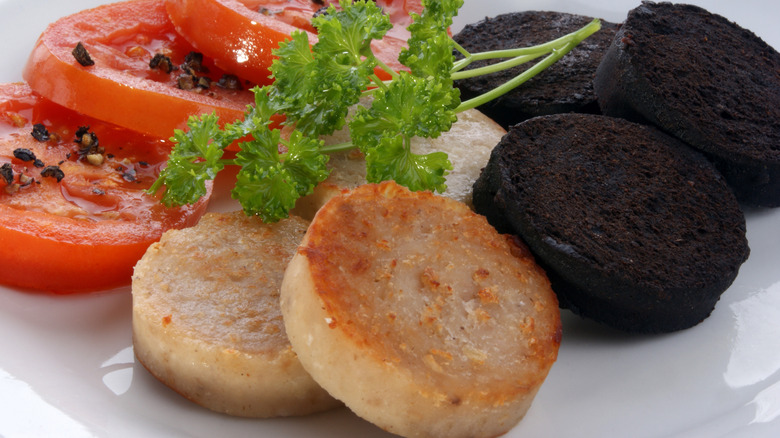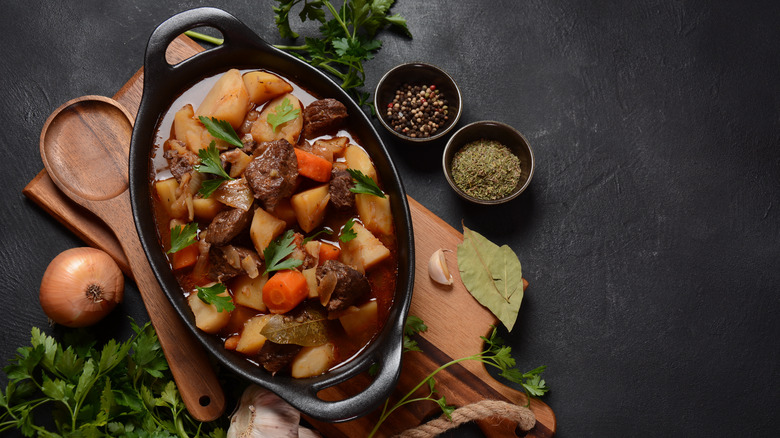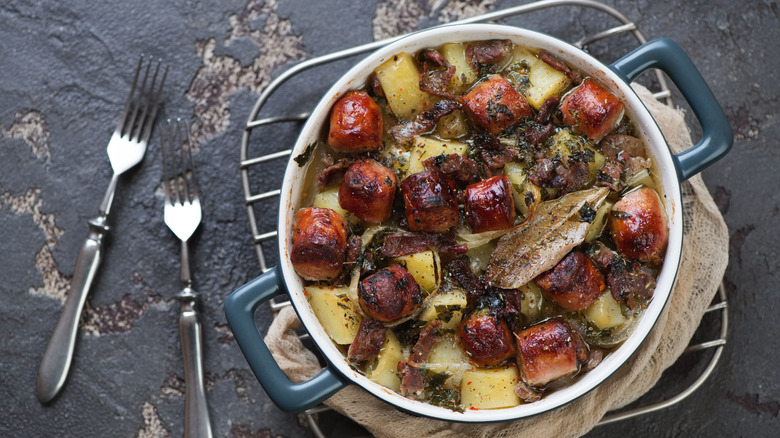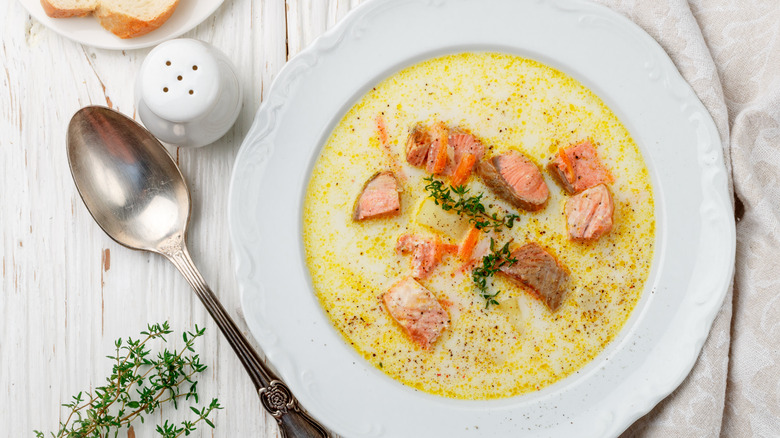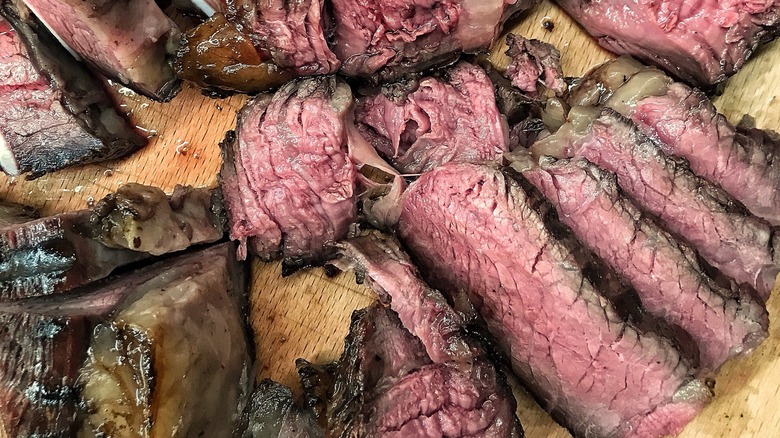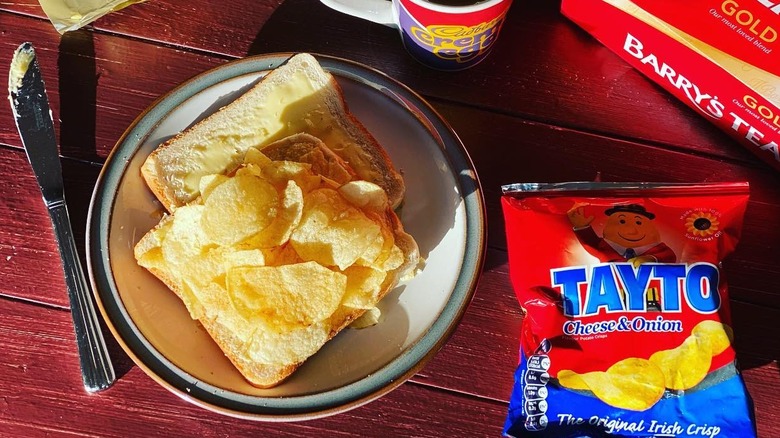13 Iconic Irish Foods You Need To Try Before You Die
There's a lot to Irish cuisine beyond corned beef and cabbage. And, get ready for us to blow your mind, corned beef might not even be Irish at all.
But that doesn't mean your hopes of planning a traditional St. Patrick's Day menu have all gone out the window. Celebrating simple ingredients like lamb, sausage, onions, cream, butter, and of course potatoes (the most iconic Irish ingredient of all), there are plenty of authentic Irish foods just as delicious as that corned beef creation.
Before we get into a list of best ones, let's take a quick look at how Irish cuisine came to be. The Emerald Isle has a history stretching back thousands of years, and, while its story is filled with rich culture and tradition, it's also plagued by poverty and famine. The country was invaded and conquered no less than nine times before the end of the 18th century (via Irish Post), and many of its inhabitants lived in want for long periods of time.
But necessity is the mother of invention, and you'll find no better example than the Irish. They've persevered and are resilient and resourceful, and their forced frugality has led to a classic cuisine rooted in simple, quality ingredients. From colcannon, a mashed potato dish that might just tell you your future, to Dublin coddle or "the city man's stew," here are the most iconic Irish foods you absolutely need to try.
1. Boxty
Let's start with boxty, also known as the potato pancake. It's made by mixing both grated and mashed potatoes with milk, eggs, flour, and butter for a half pancake, half hash brown patty that's fried on the griddle until it's perfectly crispy on the outside and soft on the inside.
Boxty is quintessentially Irish because it celebrates the humble spud in all its glory. Potatoes have been a staple in Ireland for centuries, and in many ways shaped the entire trajectory of the country. According to Potatoes USA, they arrived in Ireland in the late 1500s when Sir Walter Raleigh planted the country's first spud in County Cork on a 40,000 acre estate given to him by Queen Elizabeth I for his role in suppressing a rebellion against English rule during the siege of Smerwick.
As fate would have it, potatoes were exceptionally well-suited to Irish soil, and as their numbers exploded so did Ireland's population. It skyrocketed from 1.2 million in 1590 to 8.4 million in 1841 (a number it has yet to reach again since the potato famine of 1845) and more than half of Irish citizens, primarily the rural poor, came to rely almost exclusively on potatoes for their daily nutrition.
Today, boxty is far from peasant food. Entire restaurants and cooking competitions are dedicated to it, and you can find people eating boxty for breakfast with bacon and eggs, for dinner with sautéed cabbage, and for dessert topped with sugar and custard.
2. Potato farls
Potato farls are another tasty dish the Irish devised to use potatoes. The classic recipe calls for just three simple ingredients –- mashed potatoes, flour, and melted butter –- and the resulting dough is thick enough to hold its shape as it's rolled into a thin, flat circle (the same size as a frying pan), cut into fourths, and fried for a few minutes on each side.
While potato farls might sound similar to boxty (they are both potato-based and pancake-like, after all), there are a few key differences. Boxty contains grated potatoes, making them more reminiscent of a hash brown, while potato farls use mashed potatoes only for a smoother, more bread-like texture. That makes them the perfect stand-in for toast, served for breakfast topped with butter and jam or alongside bacon and eggs to mop up the last bits of yolk.
And just in case you're wondering why they're called farls, Allrecipes notes the name farl comes from the Gaelic word "fardel," meaning four parts. That makes perfect sense given the four pieces into which potato farls are cut. Gaelic, known simply as Irish to some, is a Celtic language born in the country's early days when the land was ruled by chiefs and kings of more than 150 clans rather than a central king or government (via Discovering Ireland). The Celtic people were some of the earliest to migrate to Ireland, and their language, beliefs, cultures, and traditions had a prominent influence on early Irish culture.
3. Colcannon
When you eat a whopping 65 spuds a day, you better know how to make killer mashed potatoes –– and since the average Irish adult in 1844 did just that, they've certainly answered the call (via Slate). Rich and buttery, colcannon is an Irish mashed potato recipe made with milk, butter, leeks, and cabbage. It's so ubiquitous throughout the country that you can often find its recipe printed on sacks of potatoes.
While we'd eat these mashed potatoes any day of the week, they were traditionally served during Samhain, a Celtic festival celebrated on October 31. If that date sounds familiar, it's because Samhain is the inspiration behind Halloween. One of four Celtic festivals of the year (one to mark the end of each season), Samhain signified the time when the veil between worlds was so thin that spirits and fairies could return to the land of the living.
As described by Food & Wine, food played a major role in the festival and colcannon was one of several traditional Irish dishes used to dabble in a little fortune-telling. Small charms were hidden throughout the potatoes and said to predict the diner's future. A coin meant wealth was on the way, a ring meant you were soon to be married, and a thimble, well, let's just say you better buy a cat because you're in for life as a spinster.
4. Barmbrack
While we're on the topic of Samhain, let's talk about barmbrack. Barmbrack is a sweet Irish fruit loaf traditionally made with raisins and sultanas (also known as golden raisins) and sometimes referred to as "tea brack" since many recipes call for soaking the dried fruit in tea before mixing it through the dough. In its early days, barmbrack was made with yeast (Irish Central says the word "barm" actually comes from the word "beorma," an old English term for the yeasty foam that collects on the top of fermenting alcohol and can be skimmed off to use in baking), but many recipes today will use baking soda for ease.
According to Saveur, much like colcannon, barmbrack used to be reserved for Samhain and, if you were lucky, might have given you a peek into your future. Remember those little charms hidden in colcannon? They made an appearance in barmbrack, too, spelling out everything from marriage to dispute for the year ahead. We can't help but think they might have spelled out a broken tooth or two, too, but we digress.
Today, barmbrack recipes include all kinds of different fruits, from cherries to candied orange peel and everything in between. However you try it, we highly recommend pairing it with a cup of tea for maximum enjoyment.
5. Irish soda bread
Soda bread is another iconic Irish bread, one you'll find at breakfast, lunch, and dinner tables across the country on a regular basis. Each family has their own favorite recipe, and they can be savory or sweet, use wheat flour or white flour, contain raisins, currants or no fruit at all -– the list goes on.
What makes them all soda bread isn't that they're made with soda pop, because they aren't. Soda bread is called soda bread because it's leavened with baking soda. Irish soda bread came about during the famine that hit Ireland in the 1840s because yeast became exceedingly difficult to get and soda bread could be made with just a few essential ingredients — flour, baking soda, buttermilk, and salt. It's the reaction of the acid in the buttermilk and the base of the baking soda that makes the bread rise.
Irish soda bread is one of those foods that shines on its own, so it's best served simply with some high-quality Irish butter. Which brings us to ...
6. Irish butter
Before the arrival of the potato, cows were the lifeblood of the country and Irish cuisine was based heavily on dairy products. As reported by Bon Appétit, the Irish consumed dairy in all kinds of ways. They drank milk, buttermilk, and a sour drink made by mixing water and whey. They ate fresh curds, old curds, and a curd known simply as "real curds." They loved bainne clabair or "thick milk," a cross between curdled milk and sour cream. And prized above all was butter.
To see just how valued it was, we need only look to old Irish legends and traditions. On May Day (another Celtic festival that marked the changing of seasons, this time from spring to summer) fairies were said to steal the butter right out of your kitchen, and the first day of a new year was customarily celebrated as the Day of the Buttered Bread (via New York Times).
Ireland is still known for its butter (and cheese) today, and according to the Irish Farmers Association, there are 18,000 dairy farmers in Ireland working to produce the high-quality products we know and love.
7. Shepherd's pie
Shepherd's pie is more like a casserole than a pie. Traditional recipes use lamb (hence the shepherd's part of the pie) and vegetables like onions, carrots, and peas all topped with a layer of, you guessed it, creamy mashed potatoes acting as the pie's "crust." While shepherd's pie actually originated in Scotland, MasterClass notes Ireland was the first to use mashed potatoes rather than a pastry crust. Before that, it would have been more akin to a classic pot pie.
Like many of Ireland's most traditional foods, shepherd's pie was born of frugality. It was an easy way to use leftover meat from the week before and any vegetables you happened to have on hand for a warm, comforting meal.
Today, many of the shepherd's pie recipes you'll see use ground beef. Technically, this is a cottage pie as opposed to a shepherd's pie. They're essentially the same thing, but cottage pie uses beef instead of lamb or mutton and sometimes has a sliced potato topping as opposed to mashed. There's also something called a Cumberland pie that uses chunks of beef instead of ground ... so many pies, so little time.
8. Black and white pudding
Black and white puddings are a quintessential part of a traditional Irish breakfast, served alongside baked beans, over-easy eggs, bacon, sautéed mushrooms and tomatoes, toast, butter, and lots of tea. Both are sausages made with some combination of a grain like oatmeal or barley (oatmeal was the classic thickener according to Epicurious), breadcrumbs, spices, and ground pork meat or liver. Some also include animal fat and, especially in Ireland, additional binders like potato flour to help keep them together.
Black pudding is especially unique because it includes the addition of pork or beef blood to give it a stronger color, flavor, and additional nutrients. While recipes vary widely, Taste of History notes that black pudding –- or blood sausage -– has been eaten around the world for centuries. It was even mentioned in Homer's "Odyssey" and has recipes dating back to the fourth century.
Since most prized meat cuts in old Ireland were reserved for the rich, black and white puddings gave rural Irishmen something nutritious to do with blood and offal, or organs, so nothing went to waste. They've stood the test of time, and remain an iconic Irish food to this day.
9. Irish stew
Traditional Irish stew was made with just a few simple ingredients –- mutton, potatoes, onions, and sometimes carrots -– and often thickened with more potatoes, mashed, instead of roux. It's the mutton and mashed potatoes that distinguish Irish stew from beef stew.
Irish stew became a staple for poor Irish families in the early 19th century when potatoes were a huge part of a traditional Irish diet and economic turmoil created mass poverty. All they needed to create a nourishing, hearty meal was a hanging pot, a fire, and a few staple ingredients they were likely to have on hand.
Today, Irish stew is often made with a lamb, a more tender alternative to mutton. Mutton comes from sheep that are more than a year old, whereas lamb comes from sheep that are under a year old. When times were lean, Irish farmers would keep their sheep around for as long as possible to reap the benefits of their wool and milk, so using mutton for their stew made more sense. That said, mutton can be much tougher meat than lamb, so cooking it for a long time, as in a stew, was a must.
10. Dublin coddle
Dublin Coddle is also known as "the city man's stew" because it became popular with Dublin's working class in the late 18th century. During Ireland's first great famine, many Irishmen moved from the countryside to the city looking for work. And, while they couldn't bring their sheep, they could bring their pigs. So, as culinary lecturer Máirtín Mac Con Iomaire of the Dublin Institute of Technology put it to the Dublin Inquirer, Dublin Coddle became a "city man's Irish stew, with sausages and rashers instead of mutton and lamb."
The key ingredients in a Dublin Coddle are pork sausage, rashers (British bacon), potatoes, and onions simmered in stock for several hours,or even overnight. The stock can be chicken, beef, water, milk –- whatever was on hand was what went into the pot. Just as delicious today as it was back then, Dublin Coddle is perfect for the end of a long day's work because you can start it in the morning and it's ready by dinner.
11. Irish seafood chowder
All this talk of potatoes and mutton might have you thinking that's all Ireland has to offer, but that's far from the truth. Let's not forget it's the Emerald Isle, so it's only fitting that it's known for some pretty delicious seafood dishes, too. Irish seafood chowder is the perfect example.
Following the tradition of using the foods on hand and in season, Irish seafood chowder can include fish, prawns, lobster, mussels, clams, whatever is caught from fresh from the sea. Some recipes call specifically for smoked salmon, which isn't surprising given Ireland is known for some of the best salmon in the world. Seafood chowder is cooked in a base of cream, milk, and wine with vegetables like leeks, onion, fennel, celery, and, yes, potatoes mixed in.
Seafood chowder is so popular in Ireland that Kinsale, County Cork, hosts an All Ireland Chowder Cook-off every year and thousands come from far and wide to see who takes the crown (via Irish Central). If you can't make it there yourself, this slow cooker seafood chowder is a close second.
12. Dexter beef
Dexter cattle are native to the Kerry region of southwestern Ireland. They're a sturdy breed in a smaller-than-average package and have evolved to survive in oftentimes harsh, shelter-less mountain landscapes. In fact, they're so hardy Butcher Magazine says they rarely require veterinary attention and can be left to graze the fields all year long, making them really and truly free-range.
But back to their size, don't let it fool you. They might be one of the smallest cattle breeds in the world, but their contribution to Irish culture is immense. Not only were they revered by rural farmers for their efficient milk production and ability to thrive even on low-quality land, they also worked as draft animals and continue doing so today. That makes them one of the few tri-purpose cattle breeds still in existence. And, if you're wondering what a draft animal is, it's any domesticated animal that can be used to pull heavy loads –- an incredibly valuable resource for farm work before the invention of modern machinery.
But back to the beef. Dexter beef has a unique spider-like marbling that makes it more tender than other types of beef and its smaller size means its steaks will be thicker than those cut from a larger animal. If that wasn't enough to convince you that you need to try it, Dexter beef also provides more omega-3 fatty acids because of the time these cows spend grazing the fields.
13. Crisp sandwich
We'll end our list with a dish that's a little more modern, but no less iconic: the crisp sandwich -– a salty, crunchy creation made with two pieces of white bread, Irish butter, and a generous handful of potato chips.
A favorite at the end of a long night or when you need a snack in a hurry, crisp sandwiches are lovingly referred to by Irish Central as an "Irish delicacy." And, while we'd like say they're easy to replicate at home, there is apparently quite a hot debate going on as to whether a crisp sandwich made without a very specific brand and flavor of potato chips -– Tayto Cheese and Onion -– is even a crisp sandwich at all. Just check out this how-to by Meanwhile in Ireland, which says using the Cheese and Onion flavor from Tayto (or another Irish brand, King) will make or break your sandwich, and straying from those specific instructions will leave you sorely disappointed.
Still, if you're willing to risk a sub-par version (which still sounds pretty darn good to us), you can make your own crisp sandwich at home by picking up your favorite bag of chips and sandwiching them between two slices of white bread slathered in butter. Just make sure you use Irish butter, which thankfully isn't nearly as hard to come by here as Taytos or Kings!
